Electrification of transport entails an inevitable increase in electricity demand, and perhaps more critically, peak power needs. While the number of electric cars on the streets has been rapidly growing in recent years, for aviation, short-haul flights are first in line for fuel exchange to electrified transportation given the limited energy density of batteries presently on offer.
In a new paper, researchers from the RISE Research Institutes of Sweden, Chalmers University of Technology and Uppsala University have quantified rising demand for airport energy from electric aviation and vehicles focusing on the airport in Visby, Sweden. They analyzed the potential techno-economical gains from installing solar and battery storage on site.
Their results show that substituting the short-haul flights with electric aviation increases the annual load demand by 89.4% and the annual peak power demand by 1 MW.
With PV alone, the grid demand reduces by 871 MWh through self-consumption (80%), the researchers found. They also observed, however, that peak reduction is modest and a consequence of the coincidence of PV output from 2.3 MW of arrays installed on-site and peak power demand.
Battery energy storage systems (BESS) further reduce grid demand, up to 18.3% compared to reference scenario with PV alone. The researchers also modeled BESS charge and discharge control in four ways, including a novel multi-objective (MO) dispatch to combine self-consumption enhancement and peak power shaving. They compared each model scenario for peak power shaving ability, self-consumption rate and pay-back period, as well as evaluated the BESS controls for annual degradation and associated cost.
They found that relative to the “PV alone” reference scenario, the newly proposed dispatch operation enhances self-consumption by 8.6% and “sufficiently shaves the power peaks.”
The MO dispatch operation also shows the lowest payback period of 6.9 years among the analyzed battery scenarios. It also reduces the battery’s idle period, resulting in an annual degradation (3.7%/a), which is in the same order of magnitude as the other dispatch algorithms (3.5–4.2%/a), the Swedish researchers reported.
The researchers discussed their findings in “Evaluating the role of solar photovoltaic and battery storage in supporting electric aviation and vehicle infrastructure at Visby Airport,” which was recently published in Applied Energy.
This content is protected by copyright and may not be reused. If you want to cooperate with us and would like to reuse some of our content, please contact: editors@pv-magazine.com.




2 comments
By submitting this form you agree to pv magazine using your data for the purposes of publishing your comment.
Your personal data will only be disclosed or otherwise transmitted to third parties for the purposes of spam filtering or if this is necessary for technical maintenance of the website. Any other transfer to third parties will not take place unless this is justified on the basis of applicable data protection regulations or if pv magazine is legally obliged to do so.
You may revoke this consent at any time with effect for the future, in which case your personal data will be deleted immediately. Otherwise, your data will be deleted if pv magazine has processed your request or the purpose of data storage is fulfilled.
Further information on data privacy can be found in our Data Protection Policy.